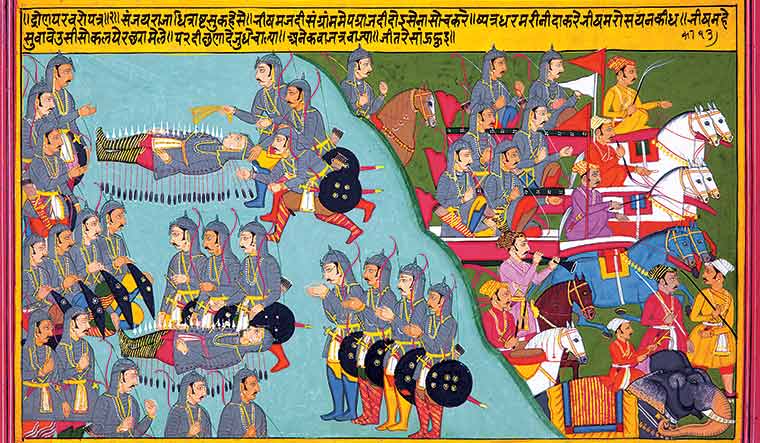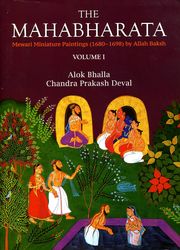In the poignant last scene of Vyasa’s Mahabharat, Indra appears in his chariot to take Yudhishthira, the eldest of the Pandava brothers, to heaven. He refuses to leave unless his four brothers and his wife Draupadi, already dead, also find a place in heaven. He also wants his devoted dog―who revealed himself to be Dharma―to be taken there.
When Yudhishthira, his dog and Indra reach heaven, the deities stand up to greet him and ask him where he wants to live. “I would like to be in the region where Draupadi and my brothers reside,” he says in the mahaprasthanika parva (the final departure) chapter of the Mahabharat. The timeless tale comes alive in the miniature paintings of Allah Baksh, a 17th century artist from Mewar. Commissioned by Maharana Jai Singh, Baksh’s 4,000 exquisite paintings feature the stories of Mahabharat from beginning to end.
The four-volume collection―The Mahabharata, Mewari Miniature Paintings (1680-1698) by Allah Baksh―is a rich addition to our culture. The volumes with gilded pages contain 2,000 paintings, accompanied by the Hindi and English translations of the Mewari colophon (imprint on the painting).
The authors, Alok Bhalla and Chandra Prakash Deval, discovered these paintings by chance at the government museum in Udaipur, along with some of Baksh’s other paintings at two museums in Udaipur and Jaipur. Their first effort was to bring out an illustrated book on the Bhagavad Gita using Baksh’s paintings. Their second and more elaborate offering is a gift to the art world. Deval has translated the Mewari text into Hindi; Bhalla translated it into English.
Baksh’s miniatures are rich in colour, simple in form and compassionate in treatment. Like our fables, they carry a moral message. The painstaking work took 18 years to create, but little is known about Baksh himself. His signatures appear on section 52 of the bhishma parva. The authors surmise that he may have belonged to the family of Nasiruddin of Chawand, who may have migrated here from Iran. Baksh follows Vyasa’s Mahabharat from the adi parva (the beginning) to the swargarohanika parva (final departure), but follows Jaimini folkloric rendering for ashwamedha parva.
The four volumes are based on these parvas. Bhalla’s commentary on each of these episodes provides a context and understanding of the different techniques and colours used by the artist to narrate the tales.
The authors say that Baksh’s paintings are unique in Indian art history as the epic has never been painted in its entirety. “The lines are confident, the colours are vibrant and the space of every painting, suffused with light, is filled with an endless variety of animals, birds, trees, rivers, mythic creatures, gods and demons,” they say.
Scholars, art students and even the public will find these volumes a valuable addition to their understanding of our religious texts told through oral traditions, where each region and language leaves its own imprint. The dialogue between Vyasa’s tale and Baksh’s visual storytelling makes this a unique art project. The message becomes more important than the sacred text.
THE MAHABHARATA, MEWARI MINIATURE PAINTINGS (1680-1698) BY ALLAH BAKSH
Four Volumes
By Alok Bhalla and Chandra Prakash Deval
Published by Niyogi Books
Price Rs12,000 (Rs3,000 for each volume); pages 1,990



